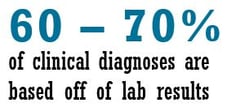
One of the major attractions of having an EMR system is the ability to track and trend patient data. Ideally, with a click of the mouse a clinician should be able to instantly see trending lab results to influence their diagnosis. According to a study  by Mayo Clinic, 60-70 of clinical diagnoses and treatments are based off of lab results. In fact, the importance of having complete and accurate lab results in the EMR was included in step one of the Meaningful Use guidelines, as stated on HealthIT.gov.
by Mayo Clinic, 60-70 of clinical diagnoses and treatments are based off of lab results. In fact, the importance of having complete and accurate lab results in the EMR was included in step one of the Meaningful Use guidelines, as stated on HealthIT.gov.
Incomplete or misplaced test results make safe and effective clinical-decision making difficult. Having lab and test results in the patient’s medical record allows for ease of access and is a reference when needed. The availability of structured lab results within the EHR contributes to office efficiencies while also assisting in the ability to make real time decisions about the patient’s care.
All well and good—so long as the information is indeed within discrete fields in the EMR. Following close behind having the right information is then incorporating Clinical Decision Support (CDS) parameter to further enhance and improve patient care. This requires incorporating the CDS Five Rights:
- The right information (evidence-based guidance, response to clinical need)
- To the right people (entire care team – including the patient)
- Through the right channels (e.g., EHR, mobile device, patient portal)
- In the right formats (e.g., order sets, flow-sheets, dashboards, patient lists)
- At the right times (for key decision or action)
In theory, this should be employed and used on a consistent basis. Unfortunately, in reality much information is sometimes not incorporated in discrete fields. Clinicians and users of EMR’s are right to ask “where is the trendable data we were promised when we were evaluating EMR’s?”
Often there is some, but the picture is not complete. A percentage of lab data is included within discrete fields, but due to a lack of time or resources other labs and reports are just scanned and attached to the patient record. Clinicians and support staff just do not have the time to manually enter the data. In the Epic EMR the image is saved in the media tab. Oftentimes there is actionable data buried within documents. The critical information necessary to provide the right information in the right format is just not where it should be. Clinicians then tab through the files and search for information. Very much the way you would with a paper file.
Fortunately, some of the largest academic medical centers in the country have robust and complete data within their EMR’s. Healthcare organizations using Extract’s intelligent automated data extraction can import the data from labs stuck in the media tab and then send the critical information to discrete fields where it can be analyzed and trended – allowing for complete assessment and diagnosis. The original image or scan can be stored in the media tab, or document management system.
Additionally, Extract’s highly flexible software can find data in virtually any report that contains actionable data, including:
Referral Packets
- Separate, classify and name each document.
- Extract and enter data directly into the EMR
- Output a summary report of patient
- Enter index values and store document in DMS
- Link the document to patient record in EMR
Lab Results:
- Capture Demographic, lab results, units, reference ranges, and resulting lab data.
- Validate patient ID
- Check for duplicate results
- Flag unexpected values
- Reconcile results with orders
- Prioritize results for verification
- Standardize order and test names to match units and reference ranges in the EMR
- Transmit standardize data to EMR.
Pathology Reports:
- Capture hundreds of data fields from dense, verbose pathology reports
- Transform and transmit normalized data to clinical analytics database.